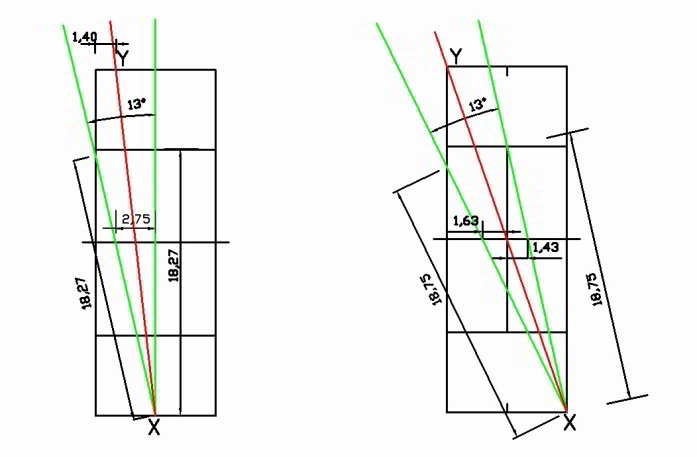Service and Return
The service is the only stroke where everything is dependent on the player who implements the stroke, and it includes the choice of position. Below you will find an analysis of where to best position the serve in order to allow yourself time to get into your next position.

Tennis rules restrict the serving player to be between the center and the sideline. The player’s movement from the center to the sideline leads to a change of the ball’s direction by only 1.0 m. The distance between the ball’s direction is always constant, that is to say the distance between the player’s position and ball’s directions is constant. The position at the court’s corner has to be excluded. Why?
Because:
- from there the player can not take the advantage since the opponent will change his position. There is no element of surprise. After every 1.0 m movement toward the sideline of the player that serves the receiver has to must move 0.25 m (1 foot) towards sideline as well.
- when the server is at the court’s corner, his court is “open” and practically the server does not have time to reach the ball if his/her opponent directs it to the other side of his/her half of the court.
Where is the best position for service implementation?
Everywhere you will find recommendations to direct the ball in the way that the ball is the most difficult for your opponent return or implement a winning shot. However, I have added one more recommendation. When all the ball’s directions have the same advantages, place the ball in the direction that best allows you to be closest to the next position you want to be in after the stroke.
In this case, the position which is located about a meter from the court’s center is the recommended position for the service implementation.
Where is the best receiver’s position?
In order to make a correct choice, you must consider the following:
You have to make your choice for court position in two directions:
- before the baseline, on the baseline or after the baseline, and;
- how far from the court’s corner on the direction to the court’s center or out to the sideline.
The choice of the position with regards to the distance of the player to the net is individual because it is dependent on:
- the opponent’s performance and speed reactions;
When the player moves 1.0 m (about 3 feet) forward from the baseline, the distance to the ball’s direction is 0.2 m (about a foot) less and the reaction time is less as well (depending on speed). When the player goes backward 1.0 m (about 3 feet) from the baseline, the distance from the player to the ball’s direction is 0.2 m (about a foot) more than when the player was on the baseline, and the reaction time is more, too.
The analysis shows that the best receiver position is about a meter away from the court’s corner towards the court’s center when the server is about a meter from the court’s center.

Leave a comment
Your email address will not be published. Required fields are marked *